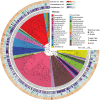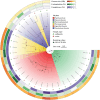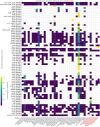Metagenomics-assembled genomes reveal microbial metabolic adaptation to athalassohaline environment, the case Lake Barkol, China
- PMID: 40535002
- PMCID: PMC12174138
- DOI: 10.3389/fmicb.2025.1550346
Metagenomics-assembled genomes reveal microbial metabolic adaptation to athalassohaline environment, the case Lake Barkol, China
Abstract
Salt-tolerant and halophilic microorganisms are critical drivers of ecosystem stability and biogeochemical cycling in athalassohaline environments. Lake Barkol, a high-altitude inland saline lake, provides a valuable natural setting for investigating microbial community dynamics and adaptation mechanisms under extreme salinity. In this study, we employed high-throughput metagenomic sequencing to characterize the taxonomic composition, metabolic potential, and ecological functions of microbial communities in both water and sediment samples from Lake Barkol. We reconstructed 309 metagenome-assembled genomes (MAGs), comprising 279 bacterial and 30 archaeal genomes. Notably, approximately 97% of the MAGs could not be classified at the species level, indicating substantial taxonomic novelty in this ecosystem. Dominant bacterial phyla included Pseudomonadota, Bacteroidota, Desulfobacterota, Planctomycetota, and Verrucomicrobiota, while archaeal communities were primarily composed of Halobacteriota, Thermoplasmatota, and Nanoarchaeota. Metabolic reconstruction revealed the presence of diverse carbon fixation pathways, including the Calvin-Benson-Bassham (CBB) cycle, the Arnon-Buchanan reductive tricarboxylic acid (rTCA) cycle, and the Wood-Ljungdahl pathway. Autotrophic sulfur-oxidizing bacteria, alongside members of Cyanobacteria and Desulfobacterota, were implicated in primary production and carbon assimilation. Nitrogen metabolism was predominantly mediated by Gammaproteobacteria, with evidence for both nitrogen fixation and denitrification processes. Sulfur cycling was largely driven by Desulfobacterota and Pseudomonadota, contributing to sulfate reduction and sulfur oxidation pathways. Microbial communities exhibited distinct osmoadaptation strategies. The "salt-in" strategy was characterized by ion transport systems such as Trk/Ktr potassium uptake and Na+/H+ antiporters, enabling active intracellular ion homeostasis. In contrast, the "salt-out" strategy involved the biosynthesis and uptake of compatible solutes including ectoine, trehalose, and glycine betaine. These strategies were differentially enriched between water and sediment habitats, suggesting spatially distinct adaptive responses to local salinity gradients and nutrient regimes. Additionally, genes encoding microbial rhodopsins were widely distributed, suggesting that rhodopsin-based phototrophy may contribute to supplemental energy acquisition under osmotic stress conditions. The integration of functional and taxonomic data highlights the metabolic versatility and ecological roles of microbial taxa in sustaining biogeochemical processes under hypersaline conditions. Overall, this study reveals extensive taxonomic novelty and functional plasticity among microbial communities in Lake Barkol and underscores the influence of salinity in structuring microbial assemblages and metabolic pathways in athalassohaline ecosystems.
Keywords: athalassohaline Lake Barkol; metabolic adaptation; metagenome-assembled genomes; microbial consortia; osmoadaptation strategies.
Copyright © 2025 Xamxidin, Zhang, Zheng, Chen and Wu.
Conflict of interest statement
The authors declare that the research was conducted in the absence of any commercial or financial relationships that could be construed as a potential conflict of interest.
Figures








Similar articles
-
Sulfur-rich deposits associated with the deep submarine volcano Fani Maoré support broad microbial sulfur cycling communities.Microbiome. 2025 Jul 15;13(1):166. doi: 10.1186/s40168-025-02153-3. Microbiome. 2025. PMID: 40665424 Free PMC article.
-
Metagenomic reconstruction of microbial genomes and biogeochemical pathways: insights into carbon and nitrogen flux dynamics in the eastern Arabian Sea.Mar Environ Res. 2025 Sep;210:107292. doi: 10.1016/j.marenvres.2025.107292. Epub 2025 Jun 16. Mar Environ Res. 2025. PMID: 40532529
-
Environment selected microbial function rather than taxonomic species in a plateau saline-alkaline wetland.Appl Environ Microbiol. 2025 Jul 23;91(7):e0220624. doi: 10.1128/aem.02206-24. Epub 2025 Jul 3. Appl Environ Microbiol. 2025. PMID: 40607849 Free PMC article.
-
Bacterial stress adaptation and antibiotic resistance in dust-transportable bioaerosols originating from the Gobi Desert.Environ Pollut. 2025 Jul 1;383:126759. doi: 10.1016/j.envpol.2025.126759. Online ahead of print. Environ Pollut. 2025. PMID: 40609888 Review.
-
Prenatal administration of progestogens for preventing spontaneous preterm birth in women with a multiple pregnancy.Cochrane Database Syst Rev. 2019 Nov 20;2019(11):CD012024. doi: 10.1002/14651858.CD012024.pub3. Cochrane Database Syst Rev. 2019. PMID: 31745984 Free PMC article.
References
-
- Alamoudi R., Barozzi A., Michoud G., van Goethem M. W., Odobel C., Chen Y., et al. (2025). Metabolic redundancy and specialisation of novel sulfide-oxidizing Sulfurimonas and Sulfurovum along the brine-seawater interface of the Kebrit deep. Environ. Microbiome 20:19. doi: 10.1186/s40793-025-00669-7, PMID: - DOI - PMC - PubMed
-
- Andrews S. FastQC: A quality control tool for high throughput sequence data. (2010). Available online at: http://www.bioinformatics.babraham.ac.uk/projects/fastqc/.
LinkOut - more resources
Full Text Sources

